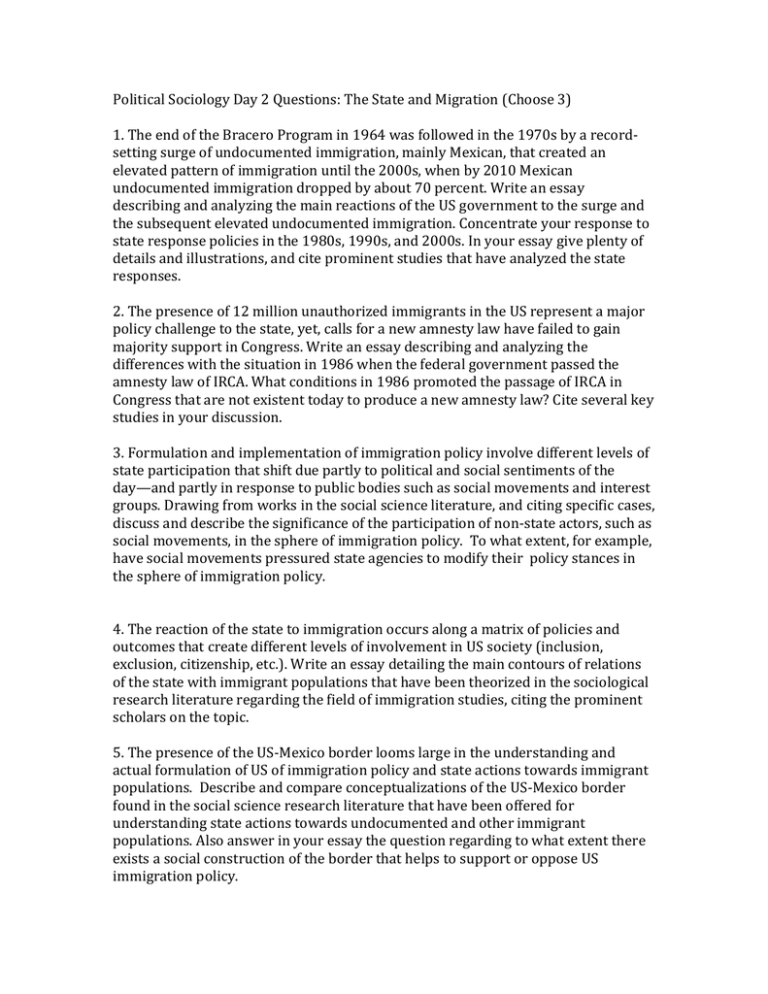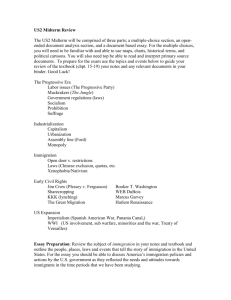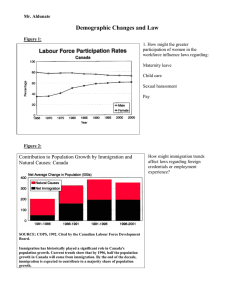Political Sociology Day 2 Questions: The State and Migration (Choose... 1. The end of the Bracero Program in 1964 was...
advertisement

Political Sociology Day 2 Questions: The State and Migration (Choose 3) 1. The end of the Bracero Program in 1964 was followed in the 1970s by a recordsetting surge of undocumented immigration, mainly Mexican, that created an elevated pattern of immigration until the 2000s, when by 2010 Mexican undocumented immigration dropped by about 70 percent. Write an essay describing and analyzing the main reactions of the US government to the surge and the subsequent elevated undocumented immigration. Concentrate your response to state response policies in the 1980s, 1990s, and 2000s. In your essay give plenty of details and illustrations, and cite prominent studies that have analyzed the state responses. 2. The presence of 12 million unauthorized immigrants in the US represent a major policy challenge to the state, yet, calls for a new amnesty law have failed to gain majority support in Congress. Write an essay describing and analyzing the differences with the situation in 1986 when the federal government passed the amnesty law of IRCA. What conditions in 1986 promoted the passage of IRCA in Congress that are not existent today to produce a new amnesty law? Cite several key studies in your discussion. 3. Formulation and implementation of immigration policy involve different levels of state participation that shift due partly to political and social sentiments of the day—and partly in response to public bodies such as social movements and interest groups. Drawing from works in the social science literature, and citing specific cases, discuss and describe the significance of the participation of non-state actors, such as social movements, in the sphere of immigration policy. To what extent, for example, have social movements pressured state agencies to modify their policy stances in the sphere of immigration policy. 4. The reaction of the state to immigration occurs along a matrix of policies and outcomes that create different levels of involvement in US society (inclusion, exclusion, citizenship, etc.). Write an essay detailing the main contours of relations of the state with immigrant populations that have been theorized in the sociological research literature regarding the field of immigration studies, citing the prominent scholars on the topic. 5. The presence of the US-Mexico border looms large in the understanding and actual formulation of US of immigration policy and state actions towards immigrant populations. Describe and compare conceptualizations of the US-Mexico border found in the social science research literature that have been offered for understanding state actions towards undocumented and other immigrant populations. Also answer in your essay the question regarding to what extent there exists a social construction of the border that helps to support or oppose US immigration policy. 6. In the 1980s and 1990s, the argument was developed that nation-states and their governments were weakening, if not actually on their way to disappearing, due to the transcending social forces of globalization and unauthorized migration. Write an essay to address the argument of a weakening state from the perspective of US immigration policy, in the context of an undocumented immigration population that now looms at about 12 million in the United States. Citing several studies, argue whether you think the state power to regulate immigration has been weakened or strengthened, or fluctuates according to public sentiments in the country.



